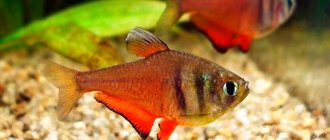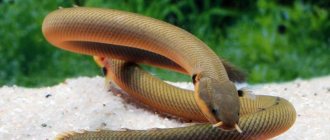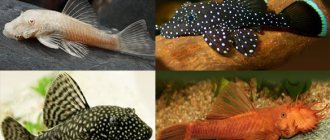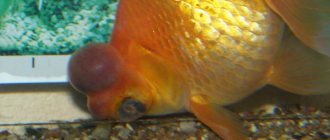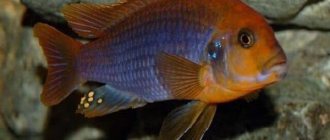Huara, uaru, triangular cichlid, yaru or wedge-spotted cichlid - there is no name for the aquarium fish, which belongs to the cichlid family and is naturally found in the fresh waters of Guiana, as well as in the reservoirs of the river basin. Amazons.
In appearance, the Uara is distinguished by a disc-shaped body, with a fairly large head, a terminal mouth and full lips. The bare ends of the rays of the long anal fin form a kind of spines. The color of this fish is most often dark brown, but bluish-black fish with white spots are also found. Greenish-beige vars, with red eyes and a dotted line throughout the body, can also be found.
Adult fish have a small fatty thickening in the throat area and three dark spots: two behind the eye and on the tail and one (wedge-shaped) on the side. There are a large number of brown spots on the body of young fish, thanks to which the fish can camouflage.
The easiest way to distinguish uaru by gender is during the breeding season. The female has a pear-shaped ovipositor, and the male has a vas deferens, bent towards the head. Uars are large fish that can reach up to 30 cm in length.
Conditions for keeping the Uara
Huaru live in flocks in which a hierarchy is observed. The fish coexist quite calmly with other peace-loving aquarium fish, especially with their cichlid relatives. However, we note that the wara is a rather shy fish, so it is better to equip the aquarium with a large number of stones and driftwood, which will serve as shelter for the fish.
However, leaving a fairly large area for swimming is also necessary. It is better to delimit the territory with flat stones, placing them vertically in the aquarium. In general, for a couple of fish you will need a fairly large aquarium with a volume of 150 liters or more. It is recommended to plant hard-leaved vegetation in the aquarium; it is best to use pots, since vars can eat plants.
Huara is an aquarium fish that stays in the middle and lower layers of water. At the same time, the fish are very picky about the condition of the water and cannot tolerate nitrogen pollution. This is why filtration and aeration in the aquarium must be powerful. Regular replacement of more than 40% of the total volume of water is also necessary. Since vars in nature live in acidic water, the acidity of the water in the aquarium should be neutral - 6.0-7.5 with a hardness of up to 15°. It is better to maintain the water temperature at 25-30 degrees.
It is necessary to feed the fish with plant food: scalded cabbage, dandelion and lettuce leaves will be a great delicacy for the fish. Among live food, fish prefer bloodworms, tubifex, coretra and shrimp.
Breeding rules
Fish become sexually mature when they reach the age of 10-12 months. However, captive breeding requires compliance with certain rules. The first thing you need to know is that these fish can spawn in a community aquarium, choosing secluded, shaded corners for breeding.
If there are other fish species living in the tank, they may be a potential threat to the fry. Spawning can occur after the water temperature rises by several degrees (28-30 degrees). Water hardness should be no higher than 8o, acidity – 6.5-7.0 pH.
A female fish can imitate the spawning process if one female replaces the dominant male. She produces 300-500 large eggs, which she lays under stones. The eggs are incubated for 72 hours, after another three days the fry will begin to swim independently in search of food. The starting food is skin glands from the parents' bodies, later they can be given Artemia larvae, rotifers, and cyclops. Fry, 2 weeks old, need plant food - give them lettuce and dandelion leaves scalded with boiling water. Parents care for their offspring independently.
Habitat in nature
The fish was first described in 1840 by Heckel. This cichlid lives in South America, in the Amazon and its tributaries. The water in such places is soft, with a pH of about 6.8.
Local residents actively catch it for consumption, but this does not threaten the population.
In nature they feed on insects, larvae, detritus, fruits and various plants.
External characteristics
The black-spotted uaru has a large head with deep-set yellow eyes and a large mouth with thick lips. The symmetry of the body is oval, slightly flattened on the sides, elongated, narrowed in the tail. The dorsal and anal fins have spiny rays, which have this appearance due to natural exposure at the ends.
These fins are long, translucent, with a blue-blue tint. The main body color of adult individuals is brown; sometimes there are specimens with bluish-black scales with a white dot. There are also fish with greenish-beige scales and a dark red dotted line.
Check out the friendly black-spotted warblers.
Mature fish have a small fatty seal at the throat, and three dark spots: two behind the eye, on the tail, and at the bottom of the body. The young are covered with many brown spots, which helps them mimic their environment to protect themselves from danger. Sexual dimorphism is weakly expressed - it is easier to determine the sex during spawning, when the male has a spermatic canal curved to the side, and the female has a pear-shaped ovipositor.
The black-spotted Huaru, like many cichlids, is not entirely suitable for keeping in a community aquarium, although it can get along with large cichlids from South American rivers. This is a schooling fish, it loves the company of its relatives with whom it feels comfortable. In the flock, behavioral characteristics are revealed and a hierarchy is formed. For four fish, a tank with a volume of 400-500 liters is required.
Black-spotted uaru fish have a disc-shaped body, measuring 20-30 cm in length. Life expectancy in captivity is 8-10 years. Mature fish of this species have a gray-brown body color, with a black wedge-shaped spot clearly visible on it, from which the fish got their name.
COMPATIBILITY WITH OTHER FISH
Not suitable for community aquariums, but suitable for life with other large cichlids from Central and South America. South American cichlids are less aggressive than their African counterparts, but in general it all depends on the size of the aquarium. Huaru can be kept with discus (although these delicate fish are not the best neighbors), with blue-spotted and turquoise acara, diamond cichlasoma, angelfish, black-striped cichlasomas, and eight-striped cichlasomas.
In general, they get along well with almost any cichlids, provided that the latter do not touch them. Black-spotted uaru are social fish; they need to be kept at least in pairs, or preferably several individuals, then they develop a hierarchy and reveal the nuances of their behavior. True, such a flock requires a fairly spacious aquarium.
GENDER DIFFERENCES
It is difficult to distinguish a male Uaru from a female, but, as a rule, he is somewhat larger, and the female has a noticeable ovipositor.
Description
The black-spotted waru has a disc-shaped body and reaches a size of 30 cm in nature. But in an aquarium it is usually smaller, about 20-25 cm.
At the same time, life expectancy with good care is up to 8-10 years.
Mature individuals are gray-brown in color, with a large black spot on the lower part of the body, by which they can be easily distinguished from other cichlids. There may also be black spots around the eyes.
The difference between a male and a female
It is difficult to determine the differences between the sexes. It is noted that an adult male has sharper genital papillae and the individuals themselves may be larger.
Mature males may develop a hump behind the head. It is also believed that red eyes are found almost exclusively in females. However, none of the above characteristics are reliable for determining gender.
Possible diseases
If all favorable conditions are created in the aquarium, the black-spotted uaru will delight you for a long time with its bright colors and interesting habits. But if you violate the water parameters or make mistakes in nutrition, the Uaru can get sick:
- Vitamin deficiency . The disease is manifested by lethargy and apathy, low mobility, and refusal to eat. In addition, there is a fading of color. The cause is poor nutrition and insufficient vitamins. Therapy and further prevention consist of changing the diet. Vitamin and mineral complexes are mandatory. It is also recommended to feed the uaru with industrial feed, which contains vitamins and minerals.
- Hexamitosis. This disease is characterized by the appearance of white spots on the head, darkening of color, exhaustion, and lack of appetite. The cause is infection by parasites due to poor quality water. Sick fish must be placed in a separate artificial tank. Treatment consists of organizing baths with Erythrocycline (per 1 liter up to 50 mg) and Trichopolum (per 1 liter 10 mg). The course of treatment is 10 days. After completing therapy, the fish should be left in a separate container for several days.
Black-spotted Uaru is an amazing and very beautiful fish with unusual habits. Particularly amusing is the ability of two females to imitate spawning. Keeping uaru is not easy, requiring certain skills from aquarists. Despite all the difficulties in creating suitable conditions and the peculiarities of breeding, the uaru is a worthy aquarium inhabitant. He is so interesting to watch that all the difficulties will be worth it to get yourself this highly intelligent fish.
Reproduction
Breeding cichlids is a complex process that only experienced aquarists can do. It is easiest to distinguish male fish from female fish during the mating season: females develop a pear-shaped ovipositor, and boys develop a vas deferens.
For successful breeding, a spawning tank with a capacity of 350 liters or more is first prepared. A net or Java moss is placed at the bottom of the fish tank, otherwise the parents will eat the offspring. During one spawning, the female lays 100-400 eggs, which after five days transform into fry. Huaru babies grow quickly: at the age of three months, the body length of the fry reaches 6 cm. Small cuneiform cichlids are fed with artemia, rotifers and ciliates.
After a while, the fry acquire a camouflage color - the body of the fish is covered with small chestnut spots, which help the babies hide in case of danger. At the age of six months, the fish are sorted by size and moved into the aquarium with adult uaru.
Wedge-spotted cichlids are modest fish with beautiful colors and an unusual body shape. Despite the demanding phenotype regarding the composition of the water, keeping a uaru will not take much of the owner’s time and effort, and the active and interesting fish will become a decoration for an artificial reservoir.
Feeding
An omnivore, the Huaru in nature eats everything it can find. These can be various insects, as well as detritus, fruits, seeds and aquatic plants.
In the aquarium it contains both live food (bloodworms, tubifex, brine shrimp) and plant food. Moreover, the share of the latter should be quite large, since in nature it is plant foods that form the basis of nutrition.
Vegetables such as cucumbers or zucchini, lettuce, food high in spirulina are what they need. With such a diet, maybe even some plants in the aquarium will survive.
It is advisable to feed twice a day, in small portions. Since uaru are sensitive to the content of nitrates and ammonia in water, it is better not to overfeed and give a little so that the remaining food does not decompose in the ground.
Huaru, severums and geophagus:
Compatibility
Despite its timid nature, the Huaru fish does not get along well with other phenotypes, preferring to live in the company of its own kind, so at least two cuneiform cichlids are placed in the aquarium.
If the owner still wants to create a species reservoir, then the best neighbors for the uaru would be:
- African cichlids;
- discus;
- acara;
- American cichlids;
- angelfish.





